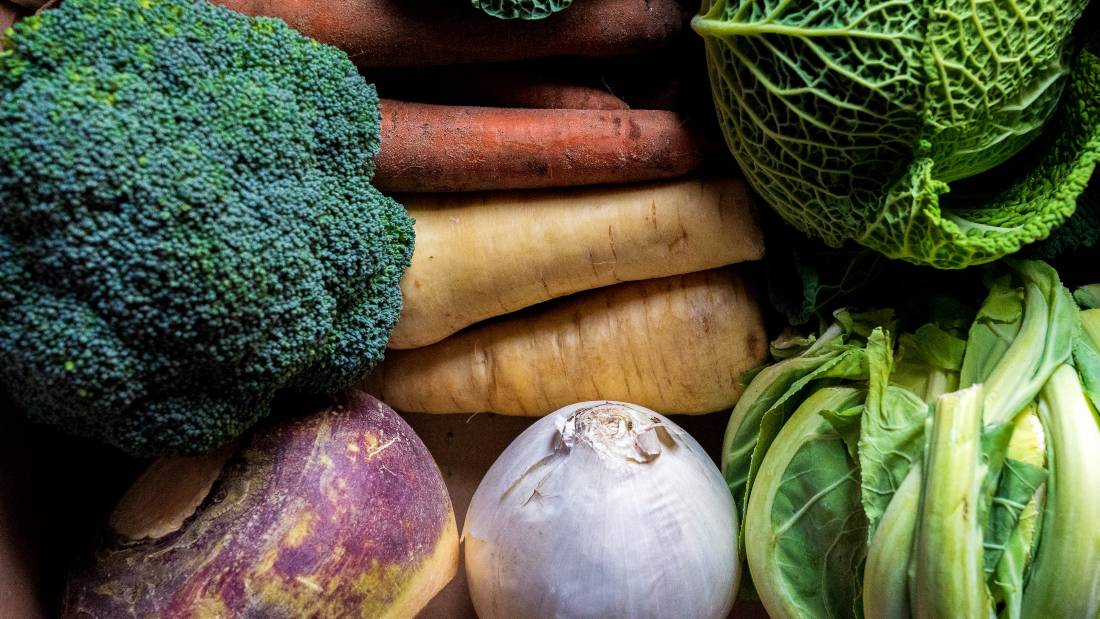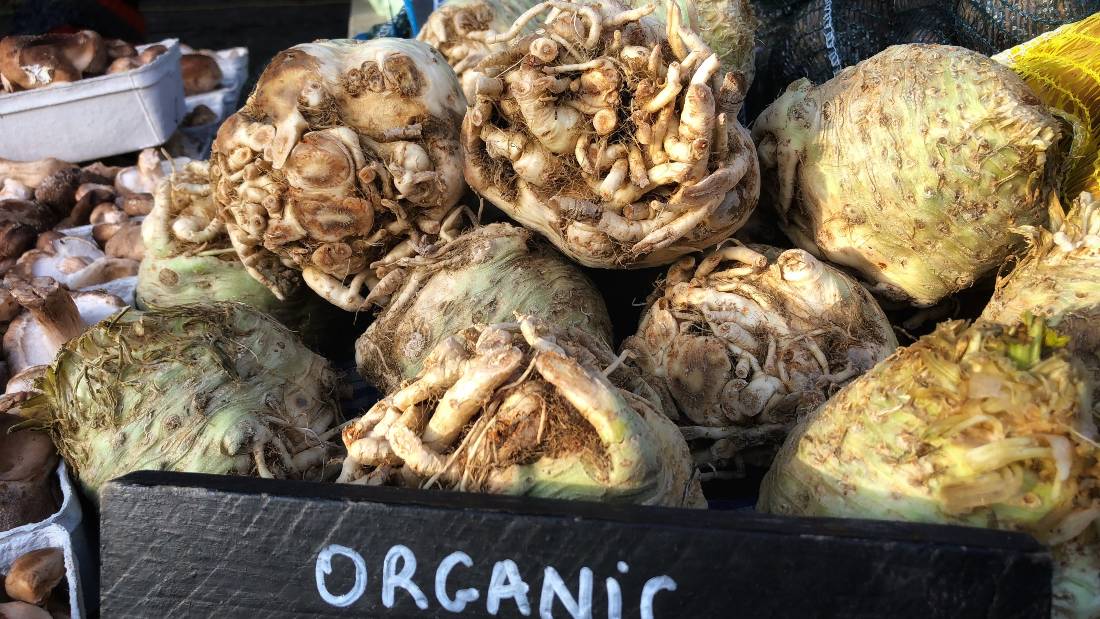10 Wonderful Winter Foods (that can be grown in the UK)

As the nights draw in and autumn ebbs into winter, it can be even more important to take care of ourselves – both physically and mentally. Cold and flus spread more easily in the colder months and for many of us, the shorter days can affect our mood. One way to show ourselves some love is to feed our body nourishing food. And what’s more, the 10 foods listed below can all be grown in the UK throughout the winter so we can feel good about shopping locally.
1. Beetroot (can be grown in the UK all year)
Beetroot is one of the best natural sources of nitrates, which are produced by special bacteria in the soil and taken up by the roots of the plant. Nitrates are converted into nitric oxide after consumption, which relaxes the blood vessels and increases their flexibility and healthy blood flow. This may become even more important as we get older as other ways of producing nitric oxide decline with age.
Research has shown that the consumption of beetroot juice can increase the blood flow to the brain, in particular the areas of the brain associated with cognitive conditions. There is even research to suggest that regular consumption of foods like beetroot may help prevent the development of vascular dementia.
The consumption of beetroot juice is also beneficial for exercise. It can help to improve endurance and generally help exercise to feel less physically demanding. This is thought to be due to the nitric oxide increasing the ability of muscles to uptake glucose from the blood, and to improve blood supply which may help the removal of waste products.
2. Brussel sprouts (can be grown in the UK from August to April)
Brussels sprouts are cruciferous vegetables alongside cabbage, kale and broccoli.
The reason why these green powerhouses are so highly praised is that all cruciferous vegetables contain very powerful natural compounds that have a strong cancer-fighting effect. Their consumption can help protect against many types of cancer (digestive tract cancers, breast, lung, prostate and kidney). These compounds are called glucosinolates and their breakdown products, such as isothiocyanates, are believed to be responsible for their health benefits.
To make the most of these compounds, you need an enzyme that is found in these veggies and helps the breakdown products to do their magic but it can get destroyed by heat. Hence, it’s best to eat some cruciferous vegetables raw or only steam them lightly. When cooking with them, you can get around this problem by adding a pinch of mustard powder which contains the necessary enzyme so you get full health benefits.
3. Pears (can be grown in the UK from September to March)
Pears are a great source of fibre, a good source of vitamin C (a medium-sized pear provides about a fifth of your recommended daily intake) and contain small amounts of many other important nutrients. Their main strength, however, really lies in the wealth of phytonutrients they offer – phenolic compounds which have beneficial health effects.
The special powers of phenolic compounds include antioxidant and anti-inflammatory effects, which mean they help to protect our tissues, including blood vessels, from damage. In addition, they encourage the growth of friendly bacteria in our gut and these bacteria, in turn, produce health-beneficial by-products that help our immune system and fight inflammation. It’s also been suggested that phenolic compounds may help to protect us from cancer.
The skin of pears contains three to four times as much of these magical compounds as the fruit’s flesh, so you know what to do – eat them whole, no peeling!

4. Celeriac (can be grown in the UK from November to May)
The root vegetable celeriac is closely related to celery, parsley and parsnips.
Like most vegetables, it is rich in antioxidants, nutrients, vitamins and minerals. It is high in B vitamins and vitamins C and K and contains good amounts of phosphorus, potassium and manganese.
One of celeriac’s main benefits is its fibre content. Fibre is important to aid in digestion, regulate blood-sugar levels and keep us regular. Our gut microbiome is fuelled by fibre and is extremely important for our overall health.
5. Leeks (can be grown in the UK from August to April)
Leeks are nutrient-dense alliums like garlic, chives, shallots and onions.
Leeks are rich in carotenoids, which our body converts to vitamin A. We need vitamin A for healthy skin and mucus membranes, immune system, eye health and vision. Beta-carotene is also an antioxidant, protecting your cells and DNA from free radicals that can cause damage. Leeks also contain an antioxidant called kaempferol, which may protect against heart disease and certain cancers.
They’re also a good source of copper, manganese, iron, vitamins K and B6.
6. Rye/rye bread (can be grown in the UK from September to May)
Rye is a cereal grain like wheat and barley, and when eaten as a wholegrain, has many health benefits.
Wholegrains are a heart healthy food. Two or three servings of wholegrains a day may reduce your risk of heart disease by 20 per cent and heart attack by 30 per cent! Other research shows that replacing refined grains with wholegrains – and eating at least two servings of wholegrains daily – may reduce the risk of type 2 diabetes by 20-30 per cent.
Rye is high in potassium which plays a key role in balancing fluids in the body, nerve signal transmission, heart muscle contractions and in kidney health. A diet rich in potassium helps maintain healthy blood pressure, kidney function and helps prevent kidney stones by neutralising acid.
Rye is also a good source of B vitamins and high in fibre.
7. Pumpkins and squashes (can be grown in the UK from September to December)
The varieties with orange flesh such as common pumpkin, butternut squash or Hokkaido are rich in beta-carotene. This is a plant pigment that your body converts into vitamin A, so pumpkins and squashes with orange insides are a good source of this vital nutrient.
The whole squash family also pack a wide variety of other vitamins and minerals. They are a valuable source of vitamins C, K, some B vitamins and minerals such as potassium, copper and manganese. And to top it off, they contain a whole array of plant pigments that act as antioxidants and have health-protective properties!
ll pumpkins and squashes are a good source of healthy carbs and fibre. They are also low in fat but contain healthy unsaturated fats which we only need in small amounts. Hence, a portion of a pumpkin or squash-based dish can contribute to your daily intake of these essential fats nicely.
8. Parsnips (can be grown in the UK from July to April)
Parsnips are a root vegetable, cousins of the carrot. They are a great source of carbohydrates, fibre and vitamins C, K and folate, and are rich in antioxidants and polyphenols. Polyphenols are plant chemicals that have beneficial health effects for us when we consume them. If you’re eating a healthy, varied vegan diet full of fruit and veg, you’ll be getting plenty!
Parsnips are a great source of slow-release carbohydrates. Cooked starchy root vegetables take longer for the body to break down and so give a slower, steadier supply of energy to the body. These can help you feel fuller for longer, which in turn can help you to lose and maintain a healthy weight.
Parsnips are a great source of fibre. Just one cup of parsnip as a side dish provides 28 per cent of your recommended intake of fibre!

9. Elderberries (can be grown in the UK from October to November)
Elderberries are one of the most commonly used medicinal plants in the world and are often used to combat colds and flus. Studies have shown that their consumption can reduce the severity and length of the illness. This is because they are bursting with Vitamin C.
Like all dark berries, they are a source of powerful antioxidants – specifically quercetin, kaempferol and isorhamnetin. Elderberries get their dark colour from compounds called anthocyanins, which have anti-inflammatory effects.
Beware though, unripe and raw berries and flowers from the plant are toxic and can lead to nausea and diarrhoea (they also taste very tart so aren’t very appealing). So, for best results and to reap the rewards, make sure they are fully ripe and well-cooked – perfect in a jam or syrup.
10. Oats (can be grown in the from UK March to December)
With a protein content ranging from 12 to 24 per cent, oats are the protein champions among grains. They contain a high-quality protein called avenalin, found only in oats, which is similar to bean proteins. If you’ve never thought of oats as a protein source, think again!
Oats contain both soluble and insoluble fibre – essential for a healthy digestive system and important for effective sugar and fat metabolism. The soluble fibre in oats is unique in that it includes beta-glucans – a type of soluble fibre that absorbs significant amounts of water and forms a soft gel. This slows down the speed of digestion so oats can give you long-lasting energy. Regular consumption of fibre and oat beta-glucans in particular, is known to reduce cholesterol levels, help regulate blood sugar levels and aid healthy weight management.
Apart from the fact that an oat-based breakfast nicely bumps up your iron and zinc intake, your bowl of oaty goodness will also contain natural compounds called avenanthramides. These are powerful antioxidants with anti-inflammatory properties and can calm irritation and itching. So, eating oats can help with a number of inflammatory conditions whilst using skin products with oat extract can make your skin happy too!
Now, if you’re looking for warming winter recipes and inspiration for how to use some of these healthy ingredients, be sure to get your hands on Viva!’s Winter Wonderland Recipe Guide for only £3 in the Viva!shop.






